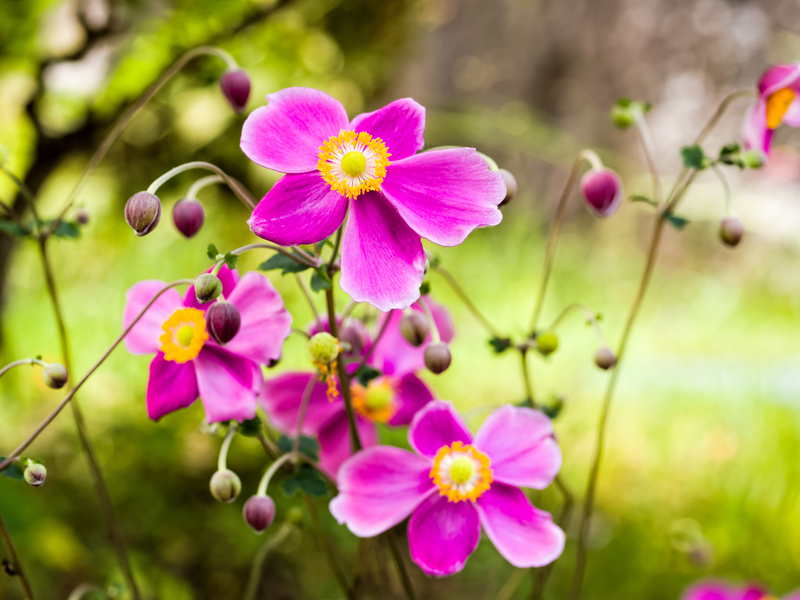Ways to ensure your garden thrives alongside dogs
Posted on 23/09/2025
Ways to Ensure Your Garden Thrives Alongside Dogs
Gardening with dogs can be a rewarding experience, but for many pet owners, it also presents unique challenges. From paw prints in flowerbeds to chewed plants, ensuring a flourishing garden while keeping your furry companions happy and safe requires thoughtful planning. In this comprehensive guide, we'll explore the best ways to ensure your garden thrives alongside dogs, covering everything from dog-safe plants to effective fencing strategies. Whether you're an avid gardener or a new dog owner, this article will help you achieve harmony between your beloved pets and a vibrant, beautiful garden.

Understanding the Challenges of Dog-Friendly Gardening
Dogs are naturally curious and energetic, which can sometimes mean trouble for your carefully curated flowers and vegetable patches. Some common garden challenges faced by dog owners include:
- Trampling: Dogs may run through beds, crushing delicate plants.
- Digging: Many breeds have a natural instinct to dig, often in freshly cultivated soil.
- Chewing: Puppies and young dogs may chew on stems, leaves, or even garden ornaments.
- Soil contamination: Urine and feces can alter soil chemistry and harm certain plants.
- Plant toxicity: Some common garden plants are toxic to dogs if ingested.
Recognizing these potential problems is the first step towards building a garden where both plants and pets can coexist happily.
Choosing Dog-Friendly Garden Plants
A crucial part of ensuring your garden thrives alongside dogs is selecting the right plants. Some species are naturally durable and non-toxic, making them better suited for gardens with pets. Here are tips for plant selection:
Select Non-Toxic Plants
Always check if a plant is safe for canine companions before introducing it into your garden. Some dog-safe plant options include:
- Marigolds (Tagetes)
- Sunflowers (Helianthus)
- Snapdragons (Antirrhinum)
- Camellias
- Roses (without pesticides)
- Ferns (excluding the asparagus fern)
- Lavender (non-toxic, but may upset tummies if eaten in large amounts)
Note: Avoid plants like azaleas, lilies, tulips, daffodils, and foxgloves as they are toxic for dogs if ingested.
Plant Hardy and Resilient Species
For active dogs, choose hardy, resilient ground covers and shrubs that can withstand a bit of roughhousing. Consider:
- Boxwood
- Heather
- Daylilies (non-toxic types)
- Hostas
- Sturdy perennials (like echinacea and rudbeckia)
Designing a Dog-Proof Garden Layout
A thoughtfully designed garden can dramatically reduce damage caused by dogs. Here are some key tips for dog-friendly garden design:
Create Designated Dog Paths
Dogs tend to create their own routes--called "dog runs"--as they patrol their turf. Anticipate this behavior by:
- Observing your dog's preferred routes and formalizing them with attractive pathways using mulch, gravel, or stepping stones.
- Ensuring paths are wide and accessible to prevent your pet from veering into beds.
- Adding visual barriers (e.g., low fencing or dense shrubs) to guide movement.
Install Raised Beds and Physical Barriers
Raised beds protect delicate plants from paws and digging. Additional strategies include:
- Using wire mesh or low decorative fencing around vulnerable areas.
- Planting dense hedges as living barriers.
- Adding trellises or lattice for climbing plants out of reach.
Arrange Furniture and Decor Strategically
Place garden furniture, boulders, or sculptures to act as natural boundaries and discourage access to off-limits areas.
Training Your Dog to Respect the Garden
One of the most effective ways to ensure your garden flourishes with dogs is through consistent, positive training. Teaching your pet appropriate behaviors helps protect your garden and enriches your dog's life.
- Leash training: Supervise your dog in the garden using a leash at first, guiding them away from forbidden zones.
- Positive reinforcement: Use treats, praise, or playtime to reward staying on paths and avoiding beds.
- Redirect digging behavior: Create a "dig zone" with sand or loose soil where digging is allowed, and gently guide your dog there when you see them about to excavate elsewhere.
- Set boundaries: Use clear verbal cues or even garden markers to indicate off-limits areas.
Consistency is key. With patience and regular training, most dogs will learn to respect your garden boundaries.
Dog-Proofing Your Garden: Fencing and Barriers
Proper fencing is essential for both garden protection and pet safety. Here are options to consider:
Perimeter Fencing
- Sturdy wooden or metal fencing is ideal for keeping dogs contained while safeguarding your garden.
- Panels should be at least 4-6 feet high for larger breeds.
- Regularly check for loose boards or escape routes.
Internal Garden Barriers
- Short decorative fences or edging can protect specific beds.
- Low wire fencing (about 18 inches high) is often enough to deter most dogs.
- Repurposed items like old branches or garden stakes can also form effective dividers.
Maintaining a Safe and Healthy Space for Your Pet
Avoid Chemical Hazards
Dogs are especially vulnerable to many common garden chemicals. To keep your garden thriving without harming your pet:
- Avoid pesticides and herbicides wherever possible; opt for organic solutions like neem oil, diatomaceous earth, or companion planting.
- Steer clear of cocoa mulch, which is toxic to dogs.
- Store fertilizers and garden chemicals securely, out of your dog's reach.
- Clean up spilled chemicals or plant feed immediately.
Prevent Soil Contamination
Dog urine can create brown patches on lawns and alter soil pH, which may inhibit plant growth. Solutions include:
- Encouraging your dog to use a designated bathroom area with appropriate substrate.
- Rinsing affected spots on lawns with water to dilute and disperse urine.
- Choosing urine-resistant grass types such as ryegrass or fescue.
Monitor for Toxic Substances
- Remove fallen fruit, berries, or mushrooms promptly.
- Be cautious of compost piles, which may harbor mold or food scraps dangerous for dogs.
- Keep garden tools, hoses, and sharp objects safely stowed after use.
Enrichment: Making Your Garden a Dog Paradise
Thriving gardens and happy dogs go hand in paw! Give your pet positive outlets for their energy and curiosity with these dog-friendly garden ideas:
- Shady lounging spots: Add a small pergola, umbrella, or leafy tree where dogs can cool off on hot days.
- Water features: A shallow fountain or splash pad offers fun and hydration.
- Toys and obstacles: Set up tunnels, agility poles, or tug toys to encourage play away from sensitive plants.
- Safe chew areas: Provide sturdy sticks or dog-safe chews where it's okay for your pup to gnaw.
Creating a dog-centric section of your yard can significantly reduce destructive behavior elsewhere by focusing your pet's activities.
Seasonal Considerations for Gardening with Dogs
Spring and Summer
- Watch for the emergence of toxic plants as they sprout or flower.
- Monitor for heat-related risks; always provide fresh water and cool resting places.
- Apply natural insect repellents to protect both plants and pets.
Fall and Winter
- Remove leaf litter that may harbor molds or fungal threats to pets.
- Keep antifreeze and other seasonal chemicals locked away--these are highly toxic.
- Clear walking paths of ice, snow, and debris for safe navigation.
Balancing Aesthetics and Function: Garden Design Inspiration
Your garden can still be beautiful and stylish while welcoming dogs. Consider these design inspirations:
- Use garden art, boulders, or colorful pots for a pop of visual interest in dog-safe zones.
- Mix textures and heights to create layered beds less prone to canine damage.
- Plant dense clusters instead of single specimens for resilience.
- Work with your dog's habits, not against them--designate "running lanes" near fences or popular patrol zones.

Common Myths About Dogs and Gardens--Debunked
- Myth: You can't have a beautiful garden with dogs.
Fact: With the right planning, training, and plant selection, gardens and dogs can coexist beautifully. - Myth: All dogs will dig up a yard.
Fact: Not all breeds are diggers, and you can train this behavior out of most pets or redirect it. - Myth: Pet urine will always ruin your lawn.
Fact: Strategic landscaping, soil management, and training can keep grass healthy and green.
Conclusion: Creating Harmony Between Dog and Garden
Ensuring your garden thrives alongside dogs is a balance of mindful design, smart plant choices, pet training, and regular maintenance. From dog-proof barriers to pet-safe landscaping, every element can work together to produce a lush, welcoming outdoor sanctuary for both you and your four-legged family members.
By following these practical tips and embracing the joys of gardening with dogs, you'll cultivate a space where plants bloom, paws play, and all members of the household thrive together.
Quick Reference: Thriving Garden Checklist for Dog Owners
- Choose non-toxic, hardy plants.
- Install fencing and raised beds as needed.
- Train your dog consistently to respect boundaries.
- Avoid toxic chemicals and materials in the garden.
- Create shaded, enriching areas for your dog to enjoy.
- Regularly inspect and maintain your garden for safety and health.
With preparation, creativity, and patience, your garden and your dog can flourish together, offering you a beautiful retreat and your pet a playful, enriching environment.

